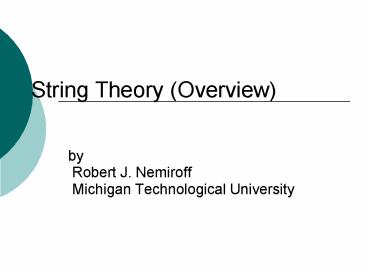String Theory (Overview) - PowerPoint PPT Presentation
Title:
String Theory (Overview)
Description:
String Theory (Overview) by Robert J. Nemiroff Michigan Technological University String Theory attempts to explain both gravitational and quantum effects in a single ... – PowerPoint PPT presentation
Number of Views:225
Avg rating:3.0/5.0
Title: String Theory (Overview)
1
String Theory (Overview)
- by
- Robert J. Nemiroff
- Michigan Technological University
2
Physics X About This Course
- Officially "Extraordinary Concepts in Physics"
- Being taught for credit at Michigan Tech
- Light on math, heavy on concepts
- Anyone anywhere is welcome
- No textbook required
- Wikipedia, web links, and lectures only
- Find all the lectures with Google at
- "Starship Asterisk" then "Physics X"
- http//bb.nightskylive.net/asterisk/viewforum.php?
f39
3
String Theory
- attempts to explain both gravitational and
quantum effects in a single theory. - models electrons and quarks not as one
dimensional points but two dimensional strings. - Strings posses only length, not height or width.
- Usually posit the existence of several extra
spatial dimensions, besides the well known 3 and
time (a fourth). - Now considered as part of 11-dimensional
M-theory. - RJN Note I am not a string theorist.
- My understanding of this particularly deep topic
may be flawed.
4
String Theory Strings of what?
- What are these strings (and branes) made out of?
- This is rarely addressed. Formally, only gross
attributes are considered length, spin, energy,
tension, background, and boundary attributes. - One possibility is that strings are made out of a
confined form of dark energy, not unlike
miniature versions of cosmic strings or domain
walls. Cosmic strings might then be stretched
versions of particle strings from the early
universe.
5
String Theory Branes
- Branes (short for membranes) are more general
than strings. - D-brane string end with Dirchlet boundary
conditions - P-brane (black) a black hole solution
generalized to 11 dimensions - NS5-brane a five dimensional object that can
mimic a magnetic monopole
6
String Theory Open and closed strings
- Strings can be open or closed. Examples
- closed string graviton
- open string photon
- Strings have
- size
- tension
- vibrations
- translation
- the ability to split and reconnect
- Designed to have many more degrees of freedom
than a point particle
7
String theory Different types
Type Spacetime dimensions Details
Bosonic 26 Only describes bosons tachyons destabilizing
I 10 Supersymmetry between forces and matter
IIA 10 Supersymmetry
IIB 10 Supersymmetry
HO 10 Supersymmetry
HE 10 Supersymmetry
8
String Theory Actions
- Define how strings move through space. Strings
will move to minimize an "action" integral. - Two types
- Nambu-Goto action
- simplest invariant action
- not all that useful
- Polyakov action
- involves string tension
- better constrained by boundary conditions
9
String theory Number of spatial dimensions
- In classical physics, EM, and GR, there are
three space dimensions and one time dimension.
These are empirical. - In string theories, the number of dimensions is
determined by things like potential energy and
the need to make force-carrying particles like
the photon massless. - All of these new dimensions are in space, not in
time.
10
String Theory Compact Dimensions
- Extra space dimensions are not observed and so
are hypothesized to be either very small or very
large. - Very small dimensions
- as small as the Planck scale (10-35 meters)
- termed "compactified"
- need small wavelength particles to fit in and
"see" them - typically "rolled up" meaning circular
- move in this dimension and you quickly return to
your starting point - analogy a garden hose viewed from far away
appears as a two-dimensional string.
11
String Theory Compact Dimensions
- Very large dimensions
- Called the "bulk"
- We live on smaller-dimensional boundaries
- termed the "brane"
- Prediction gravity much stronger on very small
scales - because one sees "leaking" from the bulk
12
String Theory Compact Dimensions
- Light and most particles are constrained to the
brane. Gravity, however, is not, and can "spread
out" over all of the dimensions of the bulk. - Acceleration due to gravity falls off as 1/r(D-1)
where D is the number of spatial dimensions - This is one reason that gravity is weaker than
electricity and magnetism.
13
Calabi-Yau Manifold
- A three dimensional projection of a
multi-dimensional object having properties and
symmetries inherent in a Calabi-Yau manifold.
14
String Theory Falsifiable?
- Does string theory make falsifiable predictions?
- Historically, some famous physicists say no
- Feynman, Glashow, Smolin
- Some string theories predict that gravity will
much stronger at very short distances. But this
is not an easily falsifiable prediction.
15
String Theory Falsifiable?
- "I wouldn't have thought that a wrong theory
should lead us to understand better the ordinary
quantum field theories or to have new insights
about the quantum states of black holes." --
Edward Witten Princeton IAS, Cite - "For more than a generation, physicists have been
chasing a will-o-the-wisp called string theory.
The beginning of this chase marked the end of
what had been three-quarters of a century of
progress. Dozens of string-theory conferences
have been held, hundreds of new Ph.D.s have been
minted, and thousands of papers have been
written. Yet, for all this activity, not a single
new testable prediction has been made, not a
single theoretical puzzle has been solved. In
fact, there is no theory so farjust a set of
hunches and calculations suggesting that a theory
might exist. And, even if it does, this theory
will come in such a bewildering number of
versions that it will be of no practical use a
Theory of Nothing." -- Jim Holt New Yorker,
2006































